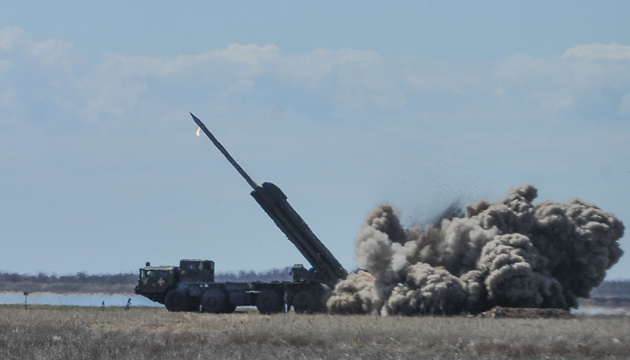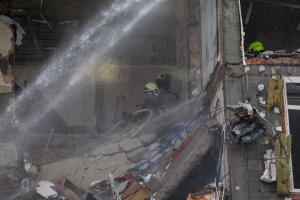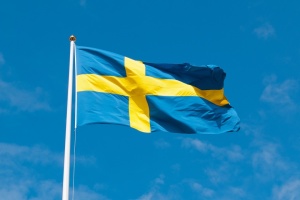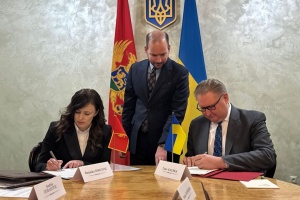
Ukraine’s defense industry can reduce Russian geopolitical influence - expert
That’s according to Oleksandr V. Danylyuk, chief of the Center for Defense Reforms, Ukrinform reports citing the expert’s oped penned for Royal United Services Institute (RUSI).
“Despite the fact that Ukraine has recently begun to receive significant amounts of foreign weapons and military equipment, post-Soviet systems still make up the bulk of the capabilities of the Armed Forces of Ukraine (AFU). (…) For a long time, as a part of their military-technical assistance, Ukraine's partners also transferred Soviet systems that were in service with former members of the Warsaw bloc or were purchased from other operators,” the expert notes.
In the short and even medium term, the issue of using and maintaining the existing post-Soviet systems remains acute. The Ukrainian defense industry possesses the necessary expertise for such maintenance and independently produces plenty of post-Soviet systems and their components. However, Russia remains the only producer of a significant number of critically needed elements.
After the start of Russia’s full-scale invasion in 2022, Ukraine began the process of substituting Russian components and successfully mastered production of many such elements but the need to provide ammunition, especially for artillery systems, MLRS, the S-300 and Buk air defense systems, is particularly critical, the oped reads.
Ukraine's partners have already spent millions procuring munitions for Soviet systems, but this is becoming more and more difficult as the market is depleting and Russia is often the only supplier.
The long requires industrial capabilities that can sustain highly intense hostilities, Danylyuk stresses, adding that in order to maintain the combat capability of the AFU, “it will be necessary to quickly ensure the ability to produce ammunition and spare parts that are currently produced only in Russia.” Ukraine has specialists who are well-versed in these systems, and often possesses the necessary technical documentation. Western defense companies have the necessary technology and a production base that can be used for both reengineering and production of improved analogues.
Undoubtedly, the AFU will be the main consumer of these products today. At the same time, after the end of the Russo-Ukrainian war, this cooperation could become an important tool of geopolitical influence and be used to displace Russia and China in the global market for post-Soviet weapons and military equipment.
Despite the fact that this market is smaller than that of NATO countries, a Western presence is important for reducing the dependence of countries operating Soviet and post-Soviet systems on Russia and China, which use military-technical cooperation to influence the governments of such countries and their foreign policies. A vivid example of such influence is India, which has a significant amount of Soviet and Russian weapons and military equipment in service. As it is dependent on Russia for their maintenance, it is forced to reckon with Moscow in its foreign policy, which is noticeable in India's position regarding Russia’s aggression in Ukraine.
Replacing Russia in these markets is also important from the point of view of limiting opportunities for Moscow to receive significant financial resources, which may then be used to develop new models of Russian weapons. Weapons sales are an important part of Russia’s economy and constitute the third largest export after hydrocarbons and food.
It is the sale of cheap weapons that allows Russia, which is weaker economically than China, the US and European countries, to maintain its influence in Sub-Saharan Africa, as well as to increase its influence in Latin America due to cooperation with not only its traditional allies of Cuba, Peru and Nicaragua, but also Venezuela, Bolivia and Ecuador, as well as such powerful economies as Brazil and Argentina. In addition, Russia is the largest supplier of weapons to Southeast Asia.
It is worth noting that the sanctions applied to the Russian defense industry have not been very effective, which has allowed Russia to sell weapons worth $8 billion in 2022 and to sign contracts for another $16 billion. The total order portfolio of Rosoboronexport is more than $42 billion.
The share of sales and maintenance of aviation equipment in the total volume of Russian defense exports exceeds 50%, with a high specific share of helicopters. Almost all of these helicopters are Mil (Mi) type. The main problem with Russian helicopters is their critical dependence on Ukrainian components, in particular, on engines produced by the Ukrainian plant Motor Sich. Despite Russia’s efforts, it has failed so far to establish its own production of high-quality analogues. Ukraine is also Russia's main competitor in the market for maintenance and modernization of the entire range of Mil helicopters. With the West’s cooperation, Ukraine could completely replace Russia in this market in two years. Western companies could supply blades, avionics, radars, fire control systems, weapons, MANPADS protection and other hi-tech components. In addition, Ukraine, in cooperation with Western companies, could establish joint production of new helicopters, which would be direct competitors of the Mil range. These new helicopters would remain cheap and flexible, but due to Western technologies, they would exceed Russian helicopters in terms of their technical characteristics.
Ukraine is also Russia’s main competitor in the market for maintenance and modernization of armored vehicles: tanks, infantry fighting vehicles and armored personnel carriers. The most important customers are India, Pakistan, Egypt, Vietnam, Iraq and Algeria and the annual market stands at $5 billion, of which about half consists of maintenance and modernization. At the same time, Ukraine is also Russia’s competitor in terms of new tanks and APCs. Cooperation with Western companies in this area may include the use of Western engines, optics, electronics, active armor, and tank barrels. Joint production of modernized versions of Ukrainian tanks such as the T-64, the BMP IFV (for its chassis) and the BTR-3/4 APCs, as well as participation in joint projects, is also possible.
The annual market for Russian air defense systems is about $1 billion (more than half of which is maintenance). In connection with the emergence of technologically simple and extremely cheap long-range strike drones, the demand for modernized air defence systems and their associated ammunition will only grow. Russian air defense systems include various modifications of the S-300, Buk, Pantsyr, Kub and S-125, which are operated by dozens of countries. After 2014, Ukraine mastered the full cycle of maintenance of such systems, established its own production of some important spare parts, and also carried out effective modernization of these systems, including through the use of Ukrainian radars, which in terms of their technical features significantly outplayed their Russian counterparts. In cooperation with Western partners, Ukraine could launch production of missiles (which is especially important for the S-300 and Buk), carry out import substitution of important components that Ukraine has never been able to produce (for example, klystrons), and if necessary, reengineer these systems. For reengineering, Ukraine will first of all need a machine park, since a significant amount of technical documentation for these systems is available in Ukraine.
Russia’s aggression in Ukraine has proved the importance of artillery and missile forces, as well as the need for large reserves of ammunition for them. Ukraine's need for Soviet calibers for barrel artillery and MLRS remains high, and other operators of Soviet systems are also likely to build up their arsenals. Ukraine can be an effective partner in the production of projectiles of 152mm, 122mm and other calibers, as well as in the production of rockets for MLRS, including modernized ones. An example is the Ukrainian Vilha, which is a cheap and highly accurate modernized version of the Soviet Smerch MLRS (300mm). Western participation in this cooperation could include the production of rocket fuel (liquid and solid), explosives, and electronics.
The most important contribution Western partners could make to displacing Russia from its traditional markets would be the reengineering of Russian spare parts or their replacement with analogues. Direct displacement would also require political tools (application of sanctions and incentives), as well as financial incentives in the form of loans to potential consumers. It is vital that Ukraine and the West cooperate to replace Russia in these markets because otherwise the gap will be filled by China, which remains Russia’s only natural competitor apart from Ukraine. In the future, Russia could be replaced not only in markets such as India and Egypt, but also in the former Soviet Republics, the report concludes.
Photo: turchynov.com




